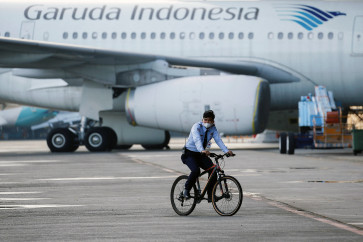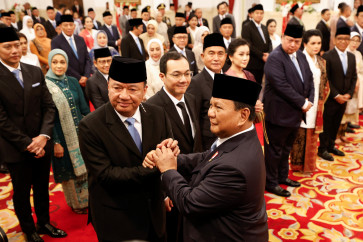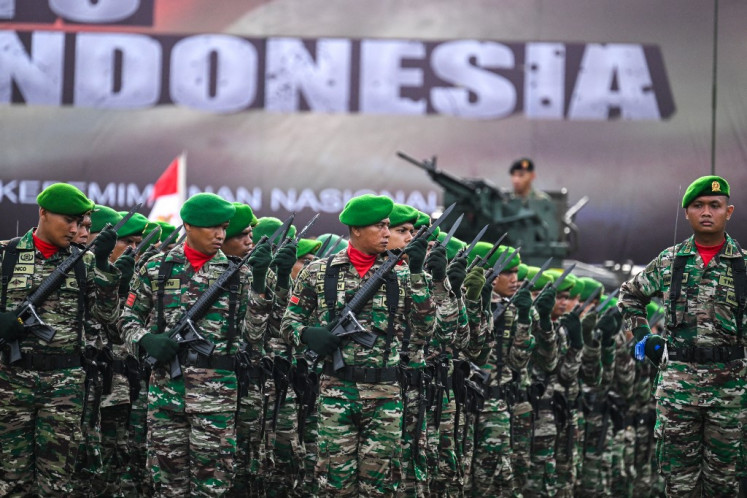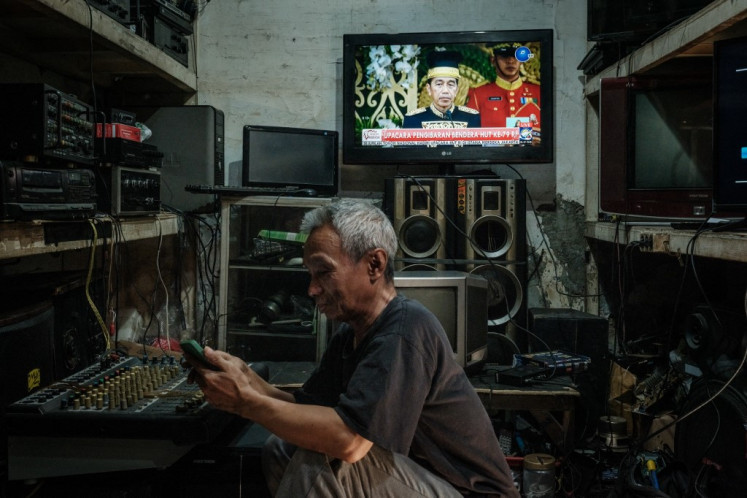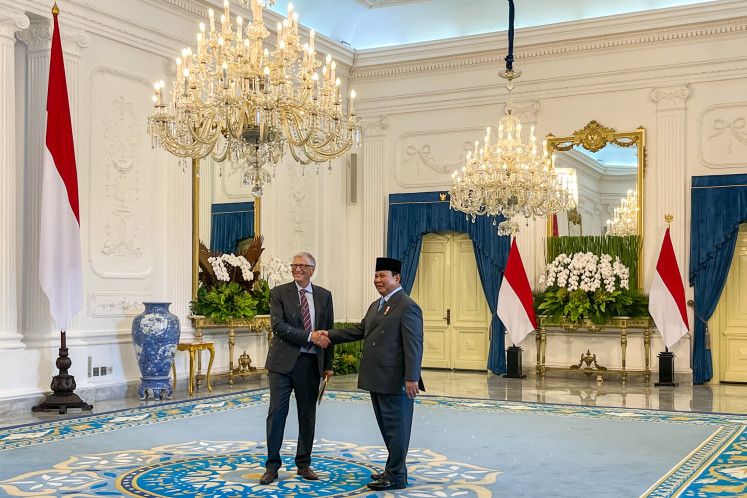Getting Personal: Andra Matin: The Elements of His Architecture
Words Yuliasri Perdani Photos Jerry adigunaIn a library of his serene yet unconventional house in the Bintaro neighborhood of Jakarta, Andra Matin, one of the most sought-after architects in Indonesia, sums up his spiritual view that, in many ways, shapes his design style
Change text size
Gift Premium Articles
to Anyone

Words Yuliasri Perdani Photos Jerry adiguna
In a library of his serene yet unconventional house in the Bintaro neighborhood of Jakarta, Andra Matin, one of the most sought-after architects in Indonesia, sums up his spiritual view that, in many ways, shapes his design style.
“I am a Muslim. I fast during Ramadhan and pray, though sometimes I skip them,” he said with a smile. “But, I am very fond of remembering God, of remembering that I am nothing.
“I believe that the most beautiful creation is the one that approaches the characteristics of God’s creations. One of them would be unpredictability. The sky can suddenly turn cloudy and pour down with rain,” he said, with a downpour outside.
“Unpredictable architecture must be exciting because it is close to God’s creations.”
The unpredictable element is clearly visible in Andra’s works. While other architects incorporate numerous colors and elements into their buildings, he finds his challenge in working with one material.
He made Balinese artisan bricks the main feature of Katamama boutique hotel in Bali. Using over 1.5 million handmade bricks, he created a dramatic look to the hotel.
Andra — real name Isandra Matin Ahmad — came into the spotlight with his innovative design for Potato Head Beach Club at Seminyak, Bali. The towering elliptical façade of mismatched teak wood shutters has in part contributed to making the beach club the hippest tourist attraction on the resort island.
“The less material, the better. Because it challenges me to create a stronger design and to hone my sensitivity,” he said.
The single-material approach is also visible in Kopi Manyar, Andra’s white-dominated café located a few steps away from his house and office that he initially built for coffee-loving employees.
“God gives us millions of colors. And in each color, there are numerous shades. So, we just need to explore one.”
Andra pointed out the white walls of the café. “They are all the same white, but they morph into a different white because some walls get the sunlight, while the other do not.”
In his career as an independent architect, he has won numerous awards, including the Indonesian Architects Association (IAI) Award for Le Bo Ye graphic design office, Gedung Dua8, Conrad wedding chapel and Komunitas Salihara complex.
His style is widely dubbed “cinematic architecture” for incorporating the elements of suspense into his design. It is like there’s a mystery waiting to be revealed in every section of the buildings.
“I like something simple but with depth. Hotels in Bali in 1980s often gave us a view to the ocean and pool as we entered the lobby. But for one resort that I designed, we had to walk through a corridor of a gravel path and a lobby before getting the best view.”
And just like in a movie, every sequence arouses different kinds of emotions.
“I like to play with space, rhythm and emotions. My designs may arouse a sense of fear through the use of narrow space in one part, and give a spacious space in another part.”

TRIBUTE TO TROPICALITY
Andra also created a peculiarly enchanting cinematic journey in his own three-story home.
The ground floor is a car park, with built-in cages for a dozen of his cats and a library with a folding glass wall that provides a view to a pohon kemboja (plumeria tree) and a pond with koi.
A ramp made of used deck timber leads to the first floor, which serves as the living and dining area and has a swimming pool. The absence of walls provides an unobstructed view to the surrounding area.
“In the past, [Indonesian people] used wall-less structures like bale bengong, pendopo and saung. We only need a roof. We don’t need a thick wall to protect us from subzero temperatures. Moreover, it saved me some budget from installing doors, windows and air conditioners.”
The second floor serves as the bedrooms for Andra’s three children, with access to a spacious grass-covered roof.
The master bedroom of the architect and his wife is separated from the main building by a green space. Andra cherishes the fact that he must uses an umbrella to get to his bedroom when it is raining. “Rain is poetic,” he said.
CHILDHOOD MEMORIES
Born in 1962, Andra strived to follow in his father’s footsteps to study art at Bandung Institute of Technology. He was not accepted and decided to study architecture instead because of its correlation with art.
Andra graduated with an architecture degree from Parahyangan Catholic University in Bandung in 1987 and spent the first 10 years of his career at PT Grahacipta Hadiprana architecture firm in Jakarta.
But it is not his architecture education nor his time at Hadiprana that first shaped his distinct architecture style. In fact, Andra’s style is rooted in a collection of childhood memories.
His cinematic architecture style is inspired by a visit to his uncle’s house in the Pakubuwono area of South Jakarta in the 1970s.
“The living room and the master bedroom were located next to each other. But to access the bedroom, I had walk through a corridor and make a few turns. This left an impression on me.”
When the little Andra visited his grandmother’s house in Purwakarta, West Java, he discovered something poetic about the elements of light and shadows in architecture.
“It was rumah panggung [a stage house]. I loved to lay on the wooden panels and see a small skylight on the ceiling. A stream of sunlight glimmered in the dark room and showed dust particles floating in the air.”
Andra left Hadiprana in 1998 to establish his eponymous architecture firm in Jakarta.
With his 28 employees, he recently worked on the new Blimbingsari Airport in Banyuwangi, East Java, dubbed the first green airport in the country.
Inspired by the shape of the traditional house of the Osing tribe of the area, the airport has a grass-covered roof. To reduce energy, the design employs skylights and promotes natural air circulation. Only the departure area is equipped with air conditioning.
He recently completed work on Al Sabar Mosque in Tulang Bawang Barat in Lampung, southern Sumatra, which is expected to jump start tourism in the area. It opened to the public on Oct. 11.
“The area is only known as a producer of rubber and cassava and hub for internal migrants. The regent asked me to design a mosque that would make people want to come there.”
Andra applies the numbers in Islam into the mosque’s design. The corners of the building reflect the number of rakaat (movements and words) in Islamic prayers. The building’s height, 30 meters, reflect the number of juz (chapters) in the Quran. The mosque also features 99 names of Allah.
“The ceiling is a stainless steel mirror so we can see the reflection of ourselves,” Andra said.
When asked about his success, he responded humbly. “I am just ordinary. I see my job as a hobby. As something fun. I enjoy the process of building something from scratch.”
His proudest achievement is when his design brings happiness to the public.
“In 2012, I revitalized Taman Rendo in Ende [Flores, East Nusa Tenggara], where [founding president] Sukarno was exiled. Now every afternoon, people spend time there. Children run around there. That’s my happiness,” he said.

